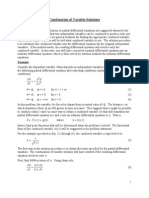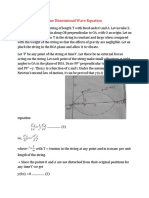4 Partial Differential Equations: Z y X X
Uploaded by
John Wanyoike Makau4 Partial Differential Equations: Z y X X
Uploaded by
John Wanyoike Makau4
PARTIAL DIFFERENTIAL EQUATIONS
4.1
Introduction
A partial differential equation (PDE) is an equation involving the partial derivatives of a
dependent variable with respective to its independent variables.
Consider the dependent variable x, y, z, t (pronounced psi) of four independent variables
x, y, z, and t . The first partial derivatives of with respect to x and t , for example, are defined
by
x x, y, z, t x, y, z, t
lim
0
x
x
(1)
x, y, z, t t x, y, z, t
lim
t t 0
t
(2)
and
respectively.
The second partial derivatives with respect to x and t are defined by
2
x
x x
(3)
and
2
t
t t
(4)
An example of a PDE is the (three-dimensional) wave equation
2
1 2
(5)
c 2 t 2
where c is a constant, t is the time variable, and 2 (pronounced del squared) is the
Laplacian operator defined in Cartesian coordinates by
2
2 y
x 2
2 y
y 2
2 y
z 2
Another example of a PDE is the heat (diffusion) given by
k 2
(6)
where k is a constant.
4.2
The Wave Equation
Consider the one-dimensional wave equation
2
x 2
1 2
(7)
c 2 t 2
where x, t is the vertical displacement of a segment of a string, located at point x , from its
equilibrium (i.e., rest position) at a given time t .
In the separation of variables method, we seek a solution to this equation of the form
X x T t
(8)
where X is a function of x only and T is function of t only. Therefore
2
x 2
2 XT
x 2
d2X
(9)
dx2
and
2
t 2
2 XT
t 2
d 2T
dt 2
(10)
Using equations (9), and (10) in equation (7) we have
T
d2X
dx2
X d 2T
c 2 dt 2
Rearranging this equation yields
1 d2X
1 d 2T
X dx2
c 2T dt 2
(11)
Equation (11) can only be satisfied if both sides of the equation are equal to a constant. For
convenience we choose this constant to be k 2 . Therefore
1 d2X
k 2
2
X dx
(12)
and
1 d 2T
2
c T dt
k 2
(13)
Rearranging these ordinary differential equations we have
d2X
k2X 0
dx2
(14)
and
d 2T
dt
c 2 k 2T 0
or
d 2T
dt 2
2T 0
(15)
where 2 c 2 k 2
Equations (14) and (15) are similar to equation (24) in topic 3. Their solutions are therefore
X x A cos kx B sin kx
(16)
T t C cost D sin t
(17)
and
where A, B, C, D are arbitrary constants.
Therefore from equations (8), (16) and (17) we see that the general solution to equation (7) is
x, t Acoskx B sin kxC cost D sin t
4.3
(18)
The Heat Equation
Consider the one-dimensional heat equation
k
2
x
(19)
where is the temperature of a material at point x at time t .
Again using the separation of variables method we assume a solution of the form
X x T t
(20)
where the variable X depends on x alone and the variable T depends on t alone. Substituting
this expression in equation (19) gives
kT
d2X
dx
dT
dt
(21)
Equation (21) may be rearranged thus
1 d2X
1 dT
2
X dx
kT dt
(22)
For this equation to hold each side must equal a constant, which we conveniently take as 2 .
Consequently equation (22) results in the following ODEs
d2X
dx2
2 X 0
dT
k2T 0
dt
(23)
(24)
The solution of the second order ordinary differential equation (23) is
X x Acosx B sin x
(25)
To solve the first order ordinary differential equation (24) we rearrange it as
dT
k2 dt
T
(26)
then integrating both sides of equation (26) with respect to T and t thus
1
T dT k dt
(27)
ln T k2t c
(28)
we obtain
where c is an integration constant. Writing c ln C , equation (28) becomes
ln T k2t ln C
or
ln T ln C ln
T
k2t
C
This implies that
T
exp k2t
C
or
T t C exp k2t
(29)
Substituting the solutions (25) and (29) in equation (20) gives the general solution of the heat
equation
x, t A cosx B sin x C exp k2t
(30)
You might also like
- Manifesto On Numerical Integration of Equations of Motion Using MatlabNo ratings yetManifesto On Numerical Integration of Equations of Motion Using Matlab10 pages
- SCH 200 Atomic Structure and Chemical Bonding100% (4)SCH 200 Atomic Structure and Chemical Bonding88 pages
- 8 Periodic Linear Di Erential Equations - Floquet TheoryNo ratings yet8 Periodic Linear Di Erential Equations - Floquet Theory5 pages
- MAT612 - Lecture 1 - Introduction To PDEsNo ratings yetMAT612 - Lecture 1 - Introduction To PDEs12 pages
- On The Expected Volume of The Wiener Sausage: Doi: 10.2969/jmsj/06241113No ratings yetOn The Expected Volume of The Wiener Sausage: Doi: 10.2969/jmsj/0624111324 pages
- Partial Differential Equations: Separation of Variable SolutionsNo ratings yetPartial Differential Equations: Separation of Variable Solutions10 pages
- Using The Fourier Transform To Solve PdesNo ratings yetUsing The Fourier Transform To Solve Pdes4 pages
- Introduction To Partial Differential Equations: 2.1 Basic Properties of PDESNo ratings yetIntroduction To Partial Differential Equations: 2.1 Basic Properties of PDES12 pages
- Transverse Vibration of A Cantilever BeamNo ratings yetTransverse Vibration of A Cantilever Beam9 pages
- FALLSEM2019-20 MAT2002 ELA VL2019201000472 Reference Material I 29-Aug-2019 EXP 3ANo ratings yetFALLSEM2019-20 MAT2002 ELA VL2019201000472 Reference Material I 29-Aug-2019 EXP 3A5 pages
- IS241 Lecture-4 Partial Differential EquationsNo ratings yetIS241 Lecture-4 Partial Differential Equations41 pages
- 18.950 Differential Geometry: Mit OpencoursewareNo ratings yet18.950 Differential Geometry: Mit Opencourseware12 pages
- Solution of The Diffusion Equation: Introduction and Problem DefinitionNo ratings yetSolution of The Diffusion Equation: Introduction and Problem Definition37 pages
- Green's Functions in Mathematical PhysicsNo ratings yetGreen's Functions in Mathematical Physics10 pages
- Thermoelastic Analysis of A Thin Circular Plate With Radiation Type ConditionsNo ratings yetThermoelastic Analysis of A Thin Circular Plate With Radiation Type Conditions6 pages
- Basic Concepts: Partial Differential Equations (Pde)No ratings yetBasic Concepts: Partial Differential Equations (Pde)19 pages
- Koshlyakov, Smirnov, Gliner - Differential Equations of Mathematical Physics - 1964No ratings yetKoshlyakov, Smirnov, Gliner - Differential Equations of Mathematical Physics - 19648 pages
- Pure Soliton Solutions of Some Nonlinear Partial Differential EquationsNo ratings yetPure Soliton Solutions of Some Nonlinear Partial Differential Equations8 pages
- 3 Two Dimensional Steady State ConductionNo ratings yet3 Two Dimensional Steady State Conduction45 pages
- A Pseudo-Parabolic Type Equation With Nonlinear Sources: Communications in Mathematical Research 27 (1) (2011), 37-46No ratings yetA Pseudo-Parabolic Type Equation With Nonlinear Sources: Communications in Mathematical Research 27 (1) (2011), 37-4610 pages
- A Exam Presentation: Instantons and The U (1) Problem: Christian SpethmannNo ratings yetA Exam Presentation: Instantons and The U (1) Problem: Christian Spethmann44 pages
- Winitzki - Derivation of WKB ApproximationNo ratings yetWinitzki - Derivation of WKB Approximation2 pages
- 3.5 Legendre's Equation: N N N N N N N N N N NNo ratings yet3.5 Legendre's Equation: N N N N N N N N N N N4 pages
- 1.4 Cartesian Coordinate System: I J K X y ZNo ratings yet1.4 Cartesian Coordinate System: I J K X y Z3 pages
- References For ICT Impact On Business: Evalyne Ndanu I21/3789/2013 Group Leader: Evalyne NdanuNo ratings yetReferences For ICT Impact On Business: Evalyne Ndanu I21/3789/2013 Group Leader: Evalyne Ndanu1 page
- Atomic Hydrogen Spectrum and The Bohr Model of The AtomNo ratings yetAtomic Hydrogen Spectrum and The Bohr Model of The Atom29 pages
- Fundamentals of Inorganic Chemistry: SCH 100 Dr. E. ChangamuNo ratings yetFundamentals of Inorganic Chemistry: SCH 100 Dr. E. Changamu36 pages
- Edward Maina I21/0648/2013 Group Leader Evalyn Ndanu Reference For Ict Impact On BusinessNo ratings yetEdward Maina I21/0648/2013 Group Leader Evalyn Ndanu Reference For Ict Impact On Business1 page
- An Overview of Switched-Mode Power Supplies: Integrated CircuitsNo ratings yetAn Overview of Switched-Mode Power Supplies: Integrated Circuits6 pages
- 48.lamp Illumination Control System Using Sensor CircuitNo ratings yet48.lamp Illumination Control System Using Sensor Circuit4 pages
- Research Methodology: Qudrattullah OmerkhelNo ratings yetResearch Methodology: Qudrattullah Omerkhel99 pages
- LINK BUILDING - Find Guest Post OpportunitiesNo ratings yetLINK BUILDING - Find Guest Post Opportunities1 page
- Information Note On Indonesia's ASEAN Chairmanship Priorities - As of 3 Feb 2023No ratings yetInformation Note On Indonesia's ASEAN Chairmanship Priorities - As of 3 Feb 20234 pages
- Updated Course Material 5 in Math 2 For 2nd Semester 2021 2022 For DistributionNo ratings yetUpdated Course Material 5 in Math 2 For 2nd Semester 2021 2022 For Distribution14 pages
- GR 9 Final Assessment Datesheet and SyllabusNo ratings yetGR 9 Final Assessment Datesheet and Syllabus7 pages
- Dell PowerEdge R730 and R730xd Technical Guide v1 7 CompressedNo ratings yetDell PowerEdge R730 and R730xd Technical Guide v1 7 Compressed66 pages
- BS 476-3-1975 - Fire Test On Building Materials & Structures - Part 3 - External Fire Exposure Roof TestsNo ratings yetBS 476-3-1975 - Fire Test On Building Materials & Structures - Part 3 - External Fire Exposure Roof Tests14 pages
- Weibull Analysis Guide & Case Study - Pardus ConsultingNo ratings yetWeibull Analysis Guide & Case Study - Pardus Consulting16 pages
- Angel - 2003 - Teaching Susan Glaspell's A Jury of Her Peers and TriflesNo ratings yetAngel - 2003 - Teaching Susan Glaspell's A Jury of Her Peers and Trifles17 pages
- Western Civilization 9th Edition Jackson J. Spielvogel - Read the ebook online or download it as you prefer100% (1)Western Civilization 9th Edition Jackson J. Spielvogel - Read the ebook online or download it as you prefer52 pages
- Manifesto On Numerical Integration of Equations of Motion Using MatlabManifesto On Numerical Integration of Equations of Motion Using Matlab
- 8 Periodic Linear Di Erential Equations - Floquet Theory8 Periodic Linear Di Erential Equations - Floquet Theory
- On The Expected Volume of The Wiener Sausage: Doi: 10.2969/jmsj/06241113On The Expected Volume of The Wiener Sausage: Doi: 10.2969/jmsj/06241113
- Partial Differential Equations: Separation of Variable SolutionsPartial Differential Equations: Separation of Variable Solutions
- Introduction To Partial Differential Equations: 2.1 Basic Properties of PDESIntroduction To Partial Differential Equations: 2.1 Basic Properties of PDES
- FALLSEM2019-20 MAT2002 ELA VL2019201000472 Reference Material I 29-Aug-2019 EXP 3AFALLSEM2019-20 MAT2002 ELA VL2019201000472 Reference Material I 29-Aug-2019 EXP 3A
- Solution of The Diffusion Equation: Introduction and Problem DefinitionSolution of The Diffusion Equation: Introduction and Problem Definition
- Thermoelastic Analysis of A Thin Circular Plate With Radiation Type ConditionsThermoelastic Analysis of A Thin Circular Plate With Radiation Type Conditions
- Basic Concepts: Partial Differential Equations (Pde)Basic Concepts: Partial Differential Equations (Pde)
- Koshlyakov, Smirnov, Gliner - Differential Equations of Mathematical Physics - 1964Koshlyakov, Smirnov, Gliner - Differential Equations of Mathematical Physics - 1964
- Pure Soliton Solutions of Some Nonlinear Partial Differential EquationsPure Soliton Solutions of Some Nonlinear Partial Differential Equations
- A Pseudo-Parabolic Type Equation With Nonlinear Sources: Communications in Mathematical Research 27 (1) (2011), 37-46A Pseudo-Parabolic Type Equation With Nonlinear Sources: Communications in Mathematical Research 27 (1) (2011), 37-46
- A Exam Presentation: Instantons and The U (1) Problem: Christian SpethmannA Exam Presentation: Instantons and The U (1) Problem: Christian Spethmann
- References For ICT Impact On Business: Evalyne Ndanu I21/3789/2013 Group Leader: Evalyne NdanuReferences For ICT Impact On Business: Evalyne Ndanu I21/3789/2013 Group Leader: Evalyne Ndanu
- Atomic Hydrogen Spectrum and The Bohr Model of The AtomAtomic Hydrogen Spectrum and The Bohr Model of The Atom
- Fundamentals of Inorganic Chemistry: SCH 100 Dr. E. ChangamuFundamentals of Inorganic Chemistry: SCH 100 Dr. E. Changamu
- Edward Maina I21/0648/2013 Group Leader Evalyn Ndanu Reference For Ict Impact On BusinessEdward Maina I21/0648/2013 Group Leader Evalyn Ndanu Reference For Ict Impact On Business
- An Overview of Switched-Mode Power Supplies: Integrated CircuitsAn Overview of Switched-Mode Power Supplies: Integrated Circuits
- 48.lamp Illumination Control System Using Sensor Circuit48.lamp Illumination Control System Using Sensor Circuit
- Information Note On Indonesia's ASEAN Chairmanship Priorities - As of 3 Feb 2023Information Note On Indonesia's ASEAN Chairmanship Priorities - As of 3 Feb 2023
- Updated Course Material 5 in Math 2 For 2nd Semester 2021 2022 For DistributionUpdated Course Material 5 in Math 2 For 2nd Semester 2021 2022 For Distribution
- Dell PowerEdge R730 and R730xd Technical Guide v1 7 CompressedDell PowerEdge R730 and R730xd Technical Guide v1 7 Compressed
- BS 476-3-1975 - Fire Test On Building Materials & Structures - Part 3 - External Fire Exposure Roof TestsBS 476-3-1975 - Fire Test On Building Materials & Structures - Part 3 - External Fire Exposure Roof Tests
- Weibull Analysis Guide & Case Study - Pardus ConsultingWeibull Analysis Guide & Case Study - Pardus Consulting
- Angel - 2003 - Teaching Susan Glaspell's A Jury of Her Peers and TriflesAngel - 2003 - Teaching Susan Glaspell's A Jury of Her Peers and Trifles
- Western Civilization 9th Edition Jackson J. Spielvogel - Read the ebook online or download it as you preferWestern Civilization 9th Edition Jackson J. Spielvogel - Read the ebook online or download it as you prefer






















































































































